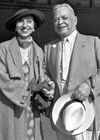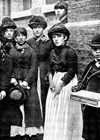History of ENT
Early Egyptian medicine: nasal trauma and surgery in the Edwin Smith Papyrus
In ancient Egypt, with its towering pyramids and bustling cityscapes along the Nile, there existed a deep-rooted civilisation that excelled in more than the grandeur of monumental architecture. Frequent wars and battles shaped Egyptian society, not only defining its political...
The pong of poverty: George Orwell on the problem of olfactory classism
Throughout his fiction and non-fiction, George Orwell incorporated references to olfaction to invoke strong reactions in his readers. For example, in Nineteen Eighty-Four the protagonist Winston describes “the pleasant smell of [Julia’s] hair”. Orwell emphasises the invasiveness and emotional force...
The Indian method: Sushruta’s influence on modern nasal reconstruction
Ancient Indian medicine, as documented in the Sushruta Samhita, contains one of the earliest known references to nasal reconstruction, including surgical techniques still resembling modern practices. (The Sanskrit word ‘Samhita’ is used to define a collection of written work, similar...
From battlefield to homefront: how the First World War shifted perceptions of deafness
The First World War marked a pivotal moment in the understanding and treatment of hearing loss and deafness. Prior to the war, deafness had been largely attributed to congenital causes. This view was influenced by a negative eugenic Darwinist ideology...
Diaphanoscopy of the paranasal sinuses (Halloween in ENT Practice)
Since time immemorial, humans have tried to enhance the limited capabilities of their sense organs. It would be a clear advantage to be able to see through objects and discern what lies inside or behind them! This concept of transillumination...
The artificial eardrum: how an eggshell membrane fed a German ENT family
In the pre-antibiotic era, purulent otitis media often resulted in a permanent eardrum perforation with hearing loss. In addition to pig or fish bladders, eggshell membranes and cigarette paper were used as eardrum prostheses. I have vivid personal boyhood memories...
Down with the nose, down with it flat
In Shakespeare’s Timon of Athens, Timon urges prostitutes to spread syphilis throughout Athens. He implores the whores, Phrynia and Timandra, to: Consumptions* sow In hollow bones of man; strike their sharp shins,And mar men’s spurring*. Crack the lawyer’s voice**, That...
A legendary ‘parotid adenoma’: teaching aid or trophy? & The stapes: a classical heresy
A legendary ‘parotid adenoma’: teaching aid or trophy? A wander through the glass cases of the newly refurbished Hunterian Museum at the Royal College of Surgeons in London presents a particularly impressive sight to any ENT surgeon. The salivary adenoma...
A soprano’s demise: a cautionary tale for the thyroid surgeon
Prior to the mid-19th century, thyroid surgery was considered excessively dangerous. The emergence of anaesthetic, antisepsis and improved instrumentation, however, increased its feasibility and frequency in Europe. The unhurried, judiciously antiseptic and haemostatic approach, advocated by Kocher, was popularised and...
Reflected glory: the race to claim the laryngeal mirror
“None of today’s young doctors can start to imagine the feeling of professional helplessness and despair that prevailed before the invention of the laryngeal mirror. Thousands of people died, whom we were not able to help, or even bring relief...
Guillotines from Joseph‑Ignace Guillotin to Greenfield Sluder
Joseph‑Ignace Guillotin. The politician and physician Joseph-Ignace Guillotin (1738-1814) was so disgusted by brutal head and shoulder injuries sustained in ‘failed attempts’ by drunken axe-wielding executioners during the French Revolution that he and surgeon Antoine Louis (1723-1792) advocated not only...
The Matchgirls and Phossy Jaw: a striking tale of industrial action
Poor working conditions, long hours, low pay – and the prospect of a dangerous and disfiguring osteonecrosis of the jaw. These were the triggers for the 1400 ‘matchgirls’ of the Bryant and May factory to strike in July 1888, a...


















